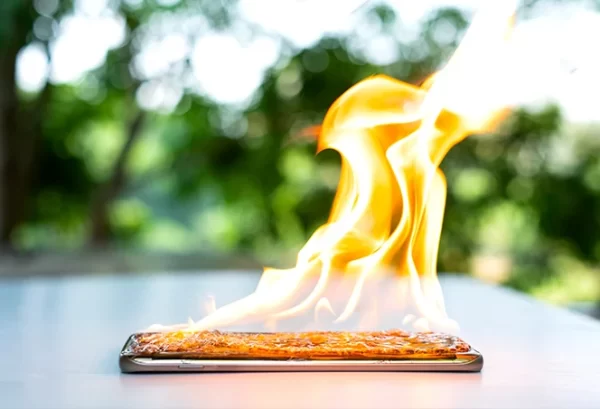
Understanding Why Your iPhone Gets Hot
It’s not uncommon for smartphones, including iPhones, to get warm during regular use. However, if your iPhone feels excessively hot to the touch, it can be concerning and may indicate an underlying issue. In this blog post, we’ll explore the reasons why your iPhone gets hot and provide solutions to help you address and prevent overheating.
Why Does My iPhone Get Hot?
1. Intensive Usage: Performing resource-intensive tasks such as gaming, video streaming, or using GPS navigation for an extended period can cause your iPhone’s processor to work harder, leading to increased heat generation.
2. Ambient Temperature: High ambient temperatures, especially in hot weather or direct sunlight, can cause your iPhone to heat up more quickly. Similarly, leaving your iPhone in a confined space like a car on a hot day can exacerbate overheating.
3. Charging: Charging your iPhone, especially using fast chargers or wireless charging pads, can generate heat as the battery charges. Additionally, using your iPhone while it’s charging can further contribute to heat buildup.
4. Software Issues: Occasionally, software glitches or background processes may cause your iPhone to work harder than usual, leading to increased heat production. This can happen due to a buggy app, outdated software, or other software-related issues.
5. Hardware Problems: In some cases, hardware issues such as a malfunctioning battery, faulty components, or poor ventilation may cause your iPhone to overheat. Physical damage or liquid exposure can also impact the iPhone’s ability to dissipate heat effectively.
Solutions to Prevent iPhone Overheating:
1. Limit Intensive Usage: Avoid prolonged gaming sessions or resource-intensive tasks on your iPhone, especially in hot environments. Take breaks and allow your iPhone to cool down periodically.
2. Optimize Settings: Adjust display brightness, disable unnecessary background processes, and close unused apps to reduce the workload on your iPhone’s processor and prevent overheating.
3. Avoid Direct Sunlight: Keep your iPhone out of direct sunlight and away from sources of heat, such as radiators or electronic devices that generate heat. Store your iPhone in a cool, shaded place whenever possible.
4. Use Genuine Accessories: Use genuine Apple chargers and accessories that are designed to work optimally with your iPhone. Avoid using cheap or counterfeit chargers, as they may not meet safety standards and could potentially cause overheating.
5. Update Software: Regularly update your iPhone’s software to the latest version provided by Apple. Software updates often include bug fixes and performance improvements that can help prevent overheating issues.
6. Monitor Battery Health: Use the Battery Health feature in the Settings app to monitor your iPhone’s battery health and performance. If you notice any significant degradation or abnormal behavior, consider getting your battery checked by an authorized service provider.
Conclusion:
While iPhones create heat during usage, severe overheating may indicate an issue. Understanding the causes of iPhone overheating and taking preventative actions can keep your iPhone functioning smoothly and prevent damage or performance concerns. If you still overheat after taking care, contact Apple Support or an authorized service provider.
Here are some frequently asked questions (FAQs) about iPhone overheating:
1. Why does my iPhone get hot when I’m not using it?
Even when idle, your iPhone may generate heat due to background processes, software updates, or connectivity features such as Bluetooth or Wi-Fi. Additionally, environmental factors like high ambient temperatures can contribute to overheating.
2. Is it normal for my iPhone to get hot while charging?
It’s normal for your iPhone to generate some heat while charging, especially if you’re using fast charging or wireless charging methods. However, excessive heat during charging could indicate a problem with the charger, battery, or iPhone itself.
3. How can I tell if my iPhone is overheating?
If your iPhone feels excessively hot to the touch, displays a temperature warning message, or shuts down unexpectedly due to overheating, it’s likely experiencing overheating issues. You may also notice degraded performance or reduced battery life.
4. What should I do if my iPhone overheats?
- If your iPhone overheats, try the following steps:
- Remove it from direct sunlight or heat sources.
- Turn it off and allow it to cool down for a few minutes.
- Avoid using intensive apps or features until the temperature decreases.
- If the overheating persists or occurs frequently, contact Apple Support for assistance.
5. Can using a case or cover cause my iPhone to overheat?
While cases and covers can provide protection for your iPhone, some cases may trap heat and reduce ventilation, leading to potential overheating issues. If you notice your iPhone getting hot with a case on, consider removing the case or using a more breathable alternative.
6. Does playing games or watching videos on my iPhone make it overheat?
Yes, playing graphically intensive games or streaming high-definition videos for extended periods can put a significant strain on your iPhone’s processor and cause it to heat up. Taking breaks and limiting usage can help prevent overheating during such activities.
7. Will restarting my iPhone help with overheating issues?
Yes, restarting your iPhone can sometimes resolve temporary software glitches or background processes that may be contributing to overheating. If your iPhone continues to overheat after restarting, consider troubleshooting further or seeking assistance from Apple Support.

Leave a Reply